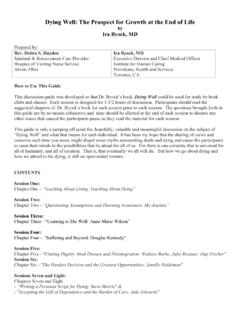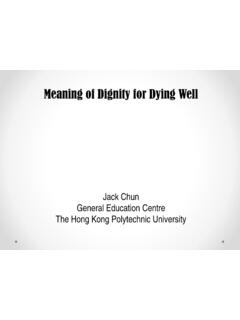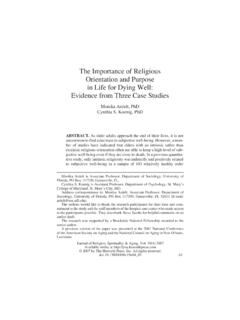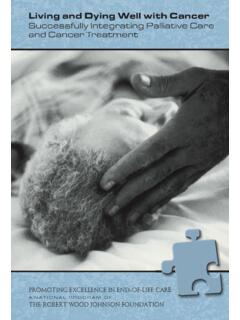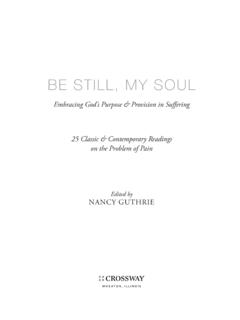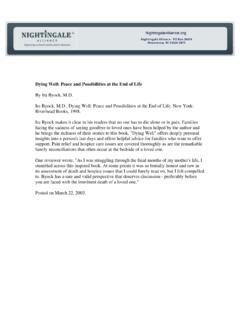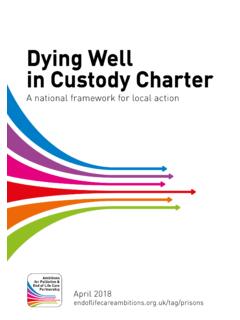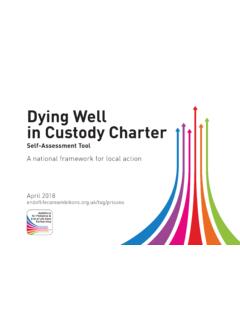Transcription of The Tidings 05-01-15 Dying well — with courage and growth
1 Dying well with courage and growth Dr. Ira Byock, a leading palliative and hospice care authority, has seen Dying persons grow when their families broken relationships are healed. May 1, 2015 - Dellinger One of Dr. Ira Byock s goals for the Providence Institute for Human Caring in Torrance is to offer whole-person health care for frail elders, seriously ill or otherwise vulnerable patients and their families. Photo: Dellinger. When asked how long he s been doing palliative and hospice care, an easy smile comes across Dr. Ira Byock s face. When I started, quips the 64-year-old Jersey boy, the Dead Sea was merely ill. As a young family practice resident in Fresno, he saw firsthand something that deeply troubled him.
2 The seriously ill and Dying mostly farmworkers and their families who came to the local hospital and county clinics were getting poor care at the end of their hard-working lives. So Byock and some coworkers started a makeshift hospice program to coordinate these patients care. They established a team of doctors, nurses, social workers and chaplains who were on call for these very sick persons. After four years, he moved to Montana. He was a family practitioner before going into emergency medicine. But then in Missoula, he was asked by the Robert Wood Johnson Foundation to head up a national palliative and hospice care program. Later, during 1995-96, he wrote: Dying well : Peace and Possibilities at the End of Life. Still a classic, it s mostly made up of poignant stories of Dying individuals he helped care for.
3 The book s appendix even offers a detailed guide for family members and the Dying to write their own stories. Transformative stories One story was about Steve Morris, a dyed-in-the-wool Montana cowboy who punched cows and rode quarter horses in rodeos on weekends. Stoic with deadpan reactions, even while on the brink of death from a lifetime of smoking, the husband and father of two grown children never showed any emotions, although he had a pickup full of damaged and broken relationships. One day when Byock happened to mention four things that matter most before Dying , the cowboy surprisingly asked, Oh, Doc, would you write those things down for me? Byock did, putting them on 3-by-5 cards: Please forgive me, I forgive you, Thank you and I love you.
4 Steve s presentation was about as stilted and woody as you can imagine, Byock recalls. But he meant it. And everybody around the table knew that for him to do this was remarkable. And it was transformative in that family. The story of his relationships changed, and the history of that family changed in a way that might have seemed unachievable without these little words. And then there was Mo Riley. She was 65 and retired after raising six kids. But she still volunteered at Loyola Sacred Heart High School. Her end-of-life journey began with a tingling pain in her wrist and reached a climax when a biopsy revealed a grade four glioblastoma. With the fast-growing tumor entwining the base of her brain, she only had a few weeks to live.
5 Although her doctor was pressuring her to continue radiation therapy, Mo finally declared that she wanted no more radiation and no chemotherapy. The only medication she would accept was for pain. When Byock visited the grandmother at her home, he was impressed by the petite, white-haired, perky woman. After she died, he wrote in Dying well , As much as any patient I have known, Mo personified the possibility of a joy within the process of letting go, transcending this world and growing into an unexplored, spiritual realm. And he is convinced that Mo s bedrock Catholic faith played a big part in her calmly withdrawing from this life and having a peaceful death. I do think that people who have a strong faith have an advantage in that they have a sense of confidence that they ll be well cared for and, frankly, that their families will be cared for, he points out.
6 A higher power is holding them in a loving way. And that clearly is an advantage when you re forced to face that this life is limited and coming to an end. He says for nonreligious Dying individuals, a sense of connection to their families can be a source of pure meaning. So can being connected to the land or an ocean or nature. What matters is the connection to something larger than themselves that will endure into an open-ended future. Assisted suicide Even back when Byock was writing Dying well , assisted suicide was being proposed as the solution to suffering at life s end. That was a time when Dr. Jack Kevorkian had built his own suicide machine. And beginning in 1990, he would go on to assist 130 ailing patients kill themselves.
7 The medical pathologist was on the cover of national magazines and appeared on 60 Minutes. Later, he served five years in prison after being convicted of second-degree murder for helping his patients end their lives. Today, with the recent highly-publicized death of Brittany Maynard in Oregon, and with similar death with dignity bills in a number of states including SB 128 in California Byock says the movement has gone totally mainstream. I think it s the wrong approach to a serious problem, he cautions. I think it is really bad social policy, which ignores urgently needed good social policy. I think the California legislature is being remarkably irresponsible in even considering this legislation, when they have not taken strong action to address the causes of the public health crisis that surrounds woeful deficiencies and serious suffering, needless suffering among Dying Americans and their families.
8 And I have long felt that from a cultural perspective, this is an issue that my field needed to address very directly, adds Byock. Unfortunately, my field has not addressed it directly at all. He says the wrong question is being asked when it comes to assisted suicide. The real issue boils down to how can we improve care for people who are seriously ill facing the end of life and the families who love and care for them. There continues to be a public health crisis that surrounds the way we die in America today. I vehemently disagree with the physician-assisted suicide movement and its proponents. Byock does agree that there is a crying need to address how people die today. The fear, anger and distrust that is driving the assisted-suicide movement is unfortunately well -founded, he says.
9 I think it is incumbent on any and all of us who oppose physician-assisted suicide to not merely tell the public what s wrong, but show them what enlightened care looks like, he stresses. And unless and until we do that, we will not be likely to change public opinion. Hospice and palliative care have made remarkable progress since Dying well came out in 1997, according to Byock. Physicians like himself and other healthcare workers have shown that much better end-of-life care is both feasible and affordable for seriously ill people and their families. But studies like last year s Institute of Medicine Report, Dying in America, keep finding that there are still serious deficiencies in the way Dying people are cared for. What s holding back our nation is the perverse financial incentives specifically designed to give more treatment and almost inattention to the personal needs and sources of suffering of seriously ill and Dying Americans, he maintains.
10 What s needed is a citizen consumer movement for palliative and hospice care to stand up against the powerful stakeholders insurance carriers, fee-for-service providers, interventionist physicians, pharmaceutical companies and durable medical equipment companies. The irony here in Los Angeles is there are multiple superb medical centers and health care systems that can provide state-of-the-art disease treatments, he says. So people are getting the best medical treatments possible throughout the course of a serious illness. And then during the last months, weeks and days of life, they re getting really bad care. And that pattern is unfortunately common. Personal side of illness Byock came to Southern California last summer to establish the Providence Institute for Human Caring.
